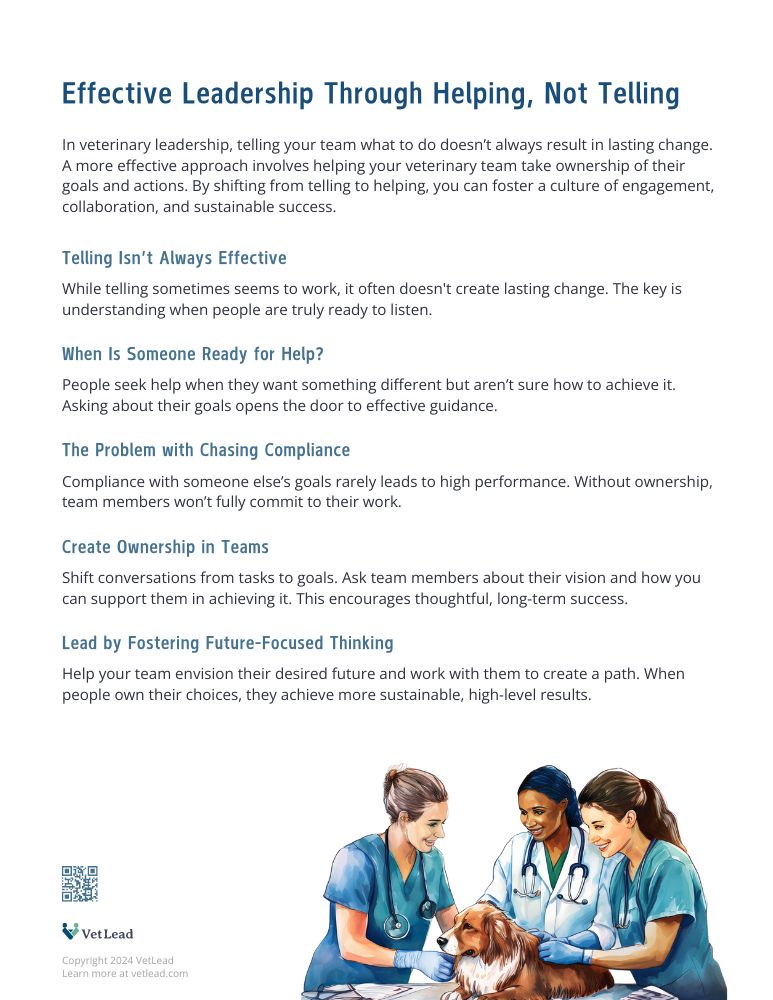It’s common during coaching conversations to focus on how a leader can help someone on their team. I often start by asking, “What have you tried so far to help that person?” This usually leads to responses like, “Well, I’ve told them over and over,” or “I keep telling them…” Telling people what to do is a go-to strategy for leaders trying to change someone’s perspective, behavior, or approach. It’s been our favorite tool since humans first developed language!
We often believe that telling brings clarity to others—after all, they just have to listen to what we already know about the situation and act on it. Sometimes, it’s more about what we feel we need to say than considering whether those words will help the other person. And, of course, telling has become a habit ingrained in how we communicate. Yet, despite all this, most of us know that telling people what to do doesn’t always bring about change. Whether you’ve managed a team, worked with a boss, or raised a teenager, you’ve likely experienced how ineffective "telling" can be.
When Telling Feels Like It’s Working (and Why It Doesn’t Last)
Sometimes, telling does seem to work. You might hear responses like, “Thank you, I needed to hear that,” or “I’ll give that a try—it might help.” These moments can feel validating, reinforcing the idea that telling someone what to do is an effective way to help or coach them.
It’s easy to begin seeing that person in a new light: “Wow, they take feedback so well!” we might think. “If only everyone else were this coachable, my team would be unstoppable.” But before we pat ourselves on the back, it’s important to consider why that person listened in the first place.
People are open to our advice for two main reasons:
- They are ready to receive help.
- They believe we can offer valuable insight.
There are also times when they feel obligated to listen, whether because we’re their boss or because the setting leaves them with little choice. But being forced to listen is very different from genuinely wanting to hear and act on someone’s input.
As leaders, our goal should be to create the conditions where our teams are truly ready to listen—not because they have to, but because they value what we have to offer.
When Is Someone Ready for Help?

People seek help when they want to achieve something different but don’t know the best path forward. They only seek guidance after deciding they want change and are figuring out how to make it happen. If your veterinary technician isn’t looking for ways to improve client communication or if your associate veterinarian isn’t actively trying to enhance their surgical skills, they’re not ready for your advice. And no amount of telling will change that.
One of the most effective ways to guide people toward a decision or outcome is by asking about their future goals. If they have a vision of where they want to go, they’ll care about finding a path to get there. But if they don’t, telling them what to do will hold no value. At that point, we’re projecting our expectations onto them, not helping them achieve their own goals.
The Problem with Chasing Compliance
People can’t effectively work toward someone else’s goals. Sure, they may comply because they have to, but compliance rarely leads to great results. For example, I remember cleaning my room as a kid by shoving everything into the closet. It wasn’t the result my parents wanted, but I technically did what they told me to do.
When people follow your plan instead of their own, they’re more likely to only repeat the action if you constantly remind them or enforce consequences. This is a recipe for exhausting management—not effective leadership.
Creating Ownership in Veterinary Teams
To truly help our teams, we need to shift the conversation from actions to goals. Ask your employees to think about their long-term vision. Help them explore their own goals instead of focusing solely on the behaviors you want them to adopt.
The Veterinary Leadership Program
Get info on this exclusive program.
Learn how to:
- 1Build an accountable team
- 2Make change happen
- 3Improve performance
- 4Hire exceptional talent
Includes live coaching.
Investment will be $897 per person
For example, instead of telling your veterinary assistant what tasks to complete, try asking, “I’d love for you to feel like you’re excelling in your role. What would that look like for you, and how can I support you in achieving that?” This approach doesn’t abandon expectations but gives the individual ownership of their next steps. By doing this, you engage the thoughtful, problem-solving part of their brain rather than the reactive, defensive part.
As leaders, we have the power to influence how people think by the way we interact with them.
Lead by Encouraging Future-Focused Thinking
Helping people shift their behavior or achieve different results comes down to two key steps:
- Help them envision a future they are motivated to work toward.
- Support them in building the path that leads there.
Remember, it’s not about getting them to adopt your vision. It’s about helping them create and pursue their own. People need choice, because choice fosters ownership, and ownership leads to sustainable change. Without choice, all we’re doing is chasing compliance, which doesn’t last—and it doesn’t lead to higher-level performance.
Lead your veterinary team by helping them build a clear picture of what they want for their future, then support them in achieving that vision. It’s how the brain works, it’s how change happens, and it’s how leaders have the most impact.

Download this Free PDF Now
Effective Leadership Through Helping, Not Telling
Share it with leaders and teams. No email address required.
How do you help members of your team? Has it improved your practice's culture? Let us know in the comments below.
